We pulled into Prince Rupert 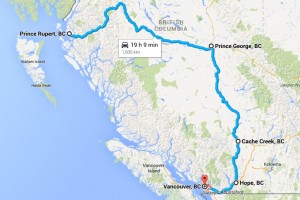 from the ferry and waited in line for Customs. Since this was the end of the line for the ferry, the Customs station was busy with the whole ship trying to get through Customs at the same time. As we left the ship in 6 lines, we merged into 3 to pass. All told, it really moved along rather quickly. We drove out of the Customs gate and up into the fog to make the drive into Prince Rupert. We had called ahead to the Prince Rupert Hotel and made arrangements for two nights stay.
from the ferry and waited in line for Customs. Since this was the end of the line for the ferry, the Customs station was busy with the whole ship trying to get through Customs at the same time. As we left the ship in 6 lines, we merged into 3 to pass. All told, it really moved along rather quickly. We drove out of the Customs gate and up into the fog to make the drive into Prince Rupert. We had called ahead to the Prince Rupert Hotel and made arrangements for two nights stay.
The next morning we set out to find Totem Park. Our map showed it to be a short walk away. Our map didn’t show the change in elevation though. Totem Park could be reached following a trail which looked to be little used and a bit overgrown. Luckily, a lady passed by walking her dogs and told us we could also take the public path between these houses to get there.
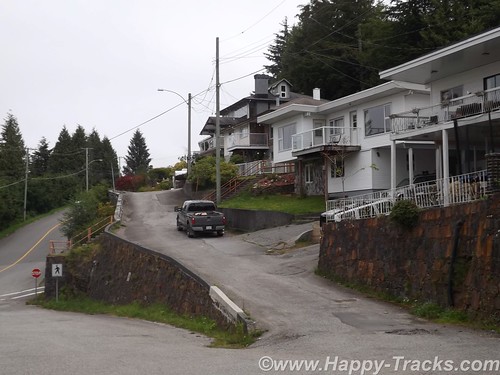
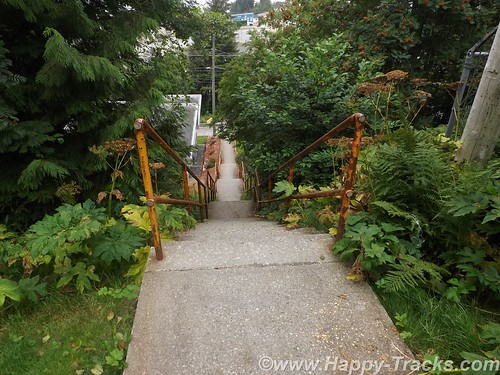
The public path was stairs. The stairs climbed up the 10 feet or so to reach the houses’ front yards and then continued up above their second stories and then still continued higher. I would estimate the climb was near 45 degrees and rose 100 feet in about 200. Then the stairs ended and the path climbed just a bit further. We finally reached the top after availing ourselves of several opportunities to stop and admire the view off the bluff and out to the harbor.
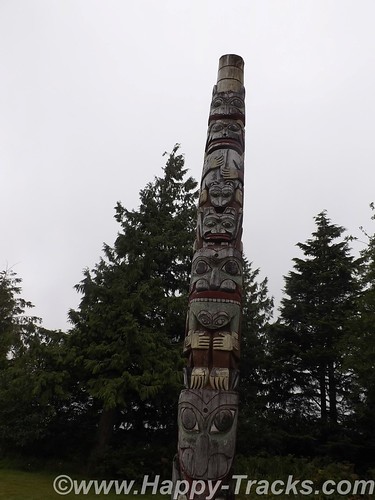
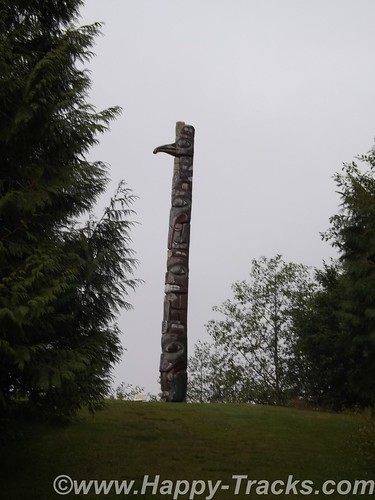
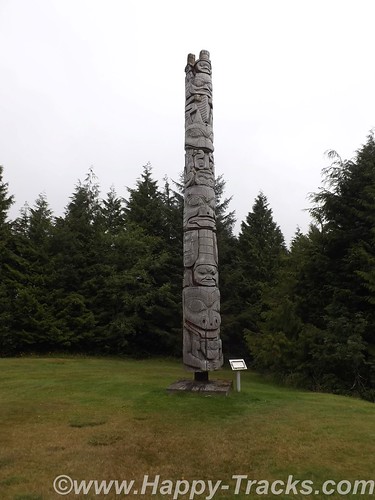
There are only three totems in Totem Park. You can see where there were two more that are no longer there. These totems are reproductions of authentic ones created by First Nations people.
We had thought there must be some universal code in totems and had tried to decipher but it just wasn’t to be. It starts with the totems having different purposes. Some are to celebrate a life, some are to commemorate an event, some are to give praise and some are to condemn or shame such as the one in Valdez meant to shame Exxon for wrongs no made right. Individual figures on the totem can also have meanings such as the frog meaning prosperity. As in other art, there is no universal key of this always means that.

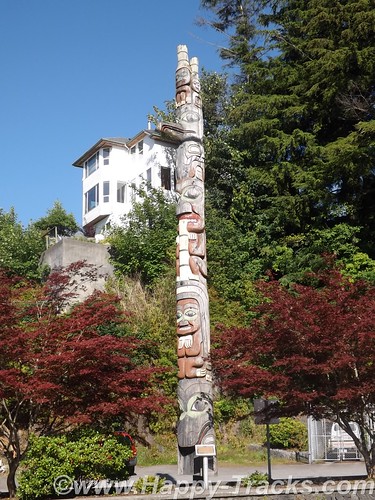
We walked down a different way than we had come up to see more of town. There were a couple of other totems standing by themselves and we also found two by city hall.
After setting on the ferry for 40 hours and the short drive to the hotel while powering our DC refrigerator, we had to jump start the truck this morning. We had been running the refrigerator off the truck battery rather than the spare battery we brought along and had used in Anchorage to jumpstart the stranded motorists. The spare battery started the truck instantly and we recharged the battery as we made our way to our next attraction.
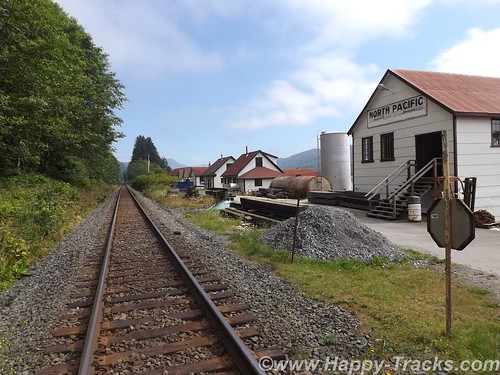
The maps and list of attractions listed the North Pacific Cannery and North Pacific Historic Fishing Village out past Port Edward. Since we had seen the cannery at Haines, we opted to go to the fishing village instead. The paved road led us toward the mouth of the Skeena River and we passed the cannery museum but then found only what looked to be private property as the road became a driveway. We carefully retraced our path but still found nothing other than the cannery museum so we went there instead.
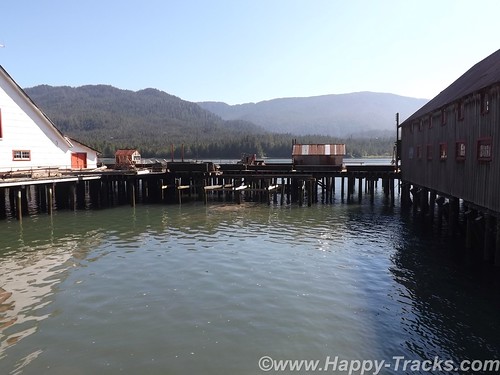
The cannery is built out over the water, probably to protect the buildings from bears and also to facilitate cleanups.

This cannery had a collection of much of the canning equipment, some from this facility and some from other locations. The tour guide described the process of making the cans from sheets of metal. This began several weeks before the fishing season so that there was an inventory of cans available to process the catch. The salmon was placed in the cans and the lids were attached and went through a heating and cooling process much like someone would can things at home. Finally the cans would be sealed with lead and a label would be placed on the cans.
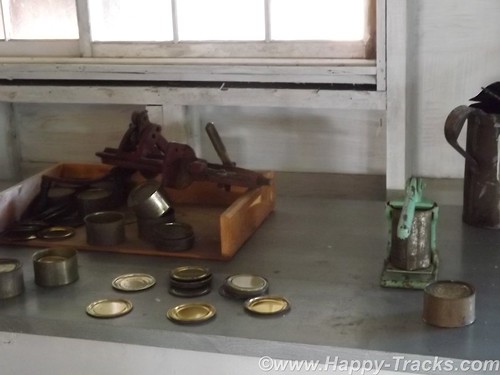
According to the guide, all the salmon that was canned here was the same and just had different labels placed on the cans. Marketing secrets of the salmon industry. The museum also had much of the equipment for the more modern vacuum-packed lead-free method of canning.
The cannery took the fish from the boats, cleaned them and then canned. Manual labor was a large part of the processing. Some of the steps required strength, some required dexterity while others just required labor. The jobs tended to be done by ethnic groups based on what we might refer to as stereotypes today. Asian women tended to do this job, First Nations men did that job and so forth.

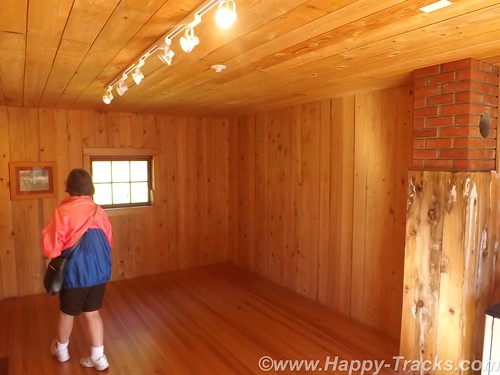
The dock included cabins that were used to house the workers during their temporary employment stints. These also tended to be segregated by ethnic groups. These were in varying states of restoration and preservation, too. This turned out to be the historic fishing village we had sought.
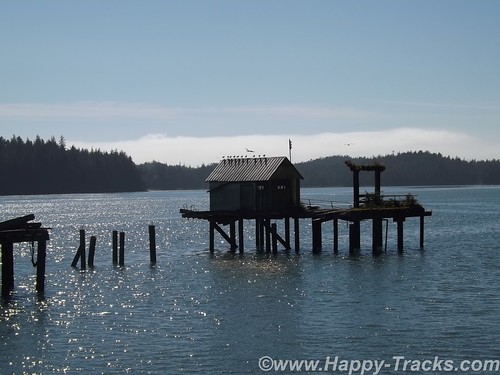
Separated from the processing building and the housing were the fuel storage tanks and pumps. There were also some administrative buildings for the cannery company.
The train tracks run between the cannery and the road for shipping the finished product. The displays also include a rather extensive model railroad and items from the time of the cannery’s productive days which was founded in 1888 and was in seasonal operation until 1968, the longest running cannery in BC.
We tried to find Canadian post card stamps while in Prince Rupert but the long weekend holiday had the post office closed.
We did find a great lunch at the Captain’s Table restaurant above the train museum park and with a great view of the water in Prince Rupert. We enjoyed it enough that we had lunch and dinner there.
We left Prince Rupert on the Monday of a long holiday and the three day weekend had other vehicles on the road heading home but it only got heavy as we came to traffic lights or bridges. Rt. 16, Yellowhead Highway, roughly parallels the Skeena River and stayed along it all the way into Prince George, 450 miles away. This was a long day for us and the weather had gotten hot (98*).
We stopped for lunch in Smithers at the Riverhouse Restaurant and then took a short detour down Main Street to see the Alpine Village which included an Alpenhorn player in the median of Main Street and a decorated bandstand.
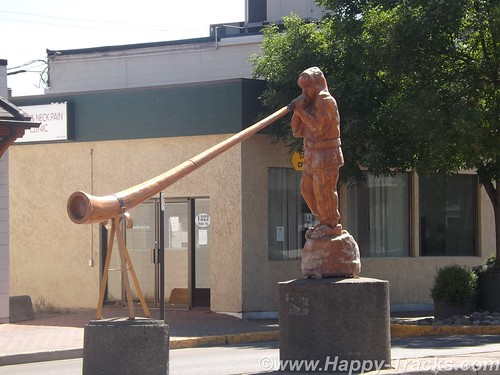

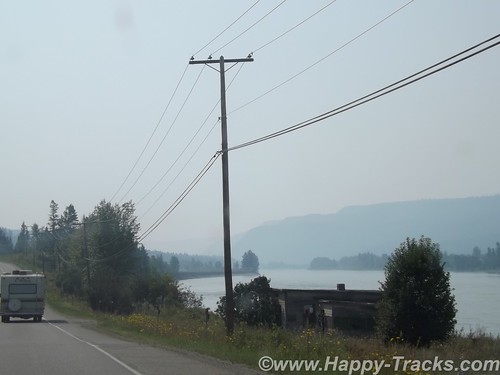
As we continued on, we became more aware of smoke in the air from the wildfires that were ongoing. When we arrived in Prince George, it turned out that many of the hotel rooms were taken by firefighters who had been brought in from other areas to help with that effort.
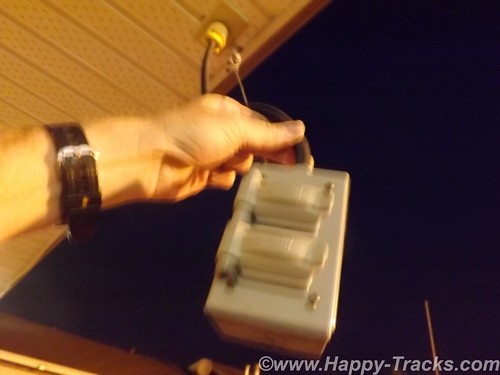
The hotel in Prince George was the first we had seen electrical outlets hanging outside the first floor overhang for winter vehicle heaters and chargers. We also discovered that all the “Do not back in” signs were to limit the exhaust from idling cars entering into the motel rooms. The misalignment of the front wheels on the truck had finally gotten to the other front tire so Keith replaced it while Betty went in search of postcards.
Some of our research includes checking out the postcard racks to see what local attractions are included there. Sometimes it helps, sometimes not so much. In the office of the hotel, Betty got involved in conversation with the desk clerk. She was born in Germany and had settled here with her husband several years ago after spending several years working here during the summers. She asked where we were headed and was disappointed that we would not be visiting Banff and Lake Louise. Betty told her we were feeling we had seen a lot of great scenery already and were headed to Vancouver to see a Canadian city instead. She did have some tips for our coming travels though, including recommendations for sights and a hotel in Vancouver.
We left Price George headed south on Rt. 97, the Cariiboo Highway. Towns (settlements?) along the way were 150 Mile House and 100 Mile House named for the way stations along the way from frontier days.

Generally, the scenery looked arid but there were signs of forestry in the lumber yards and pulp mills along the way. There was also a cairn erected to commemorate Ft. Alexandria, the last Northwest Fur trading outpost west of the Rockies.
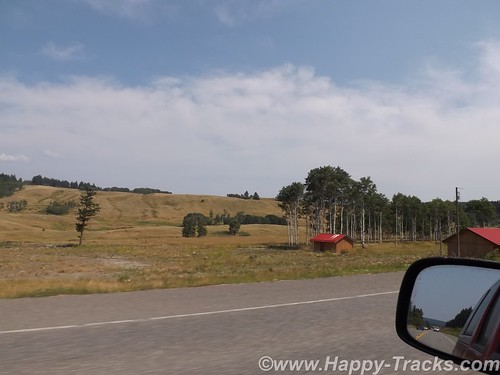
The area had been the site of mining operations in the past and when we next checked into the news, we discovered that a tailings pond had broken in Williams Lake and was in danger of polluting the drinking water and fishing waters with the toxic mess left over from the mining operations. That story was still breaking as we left the area.
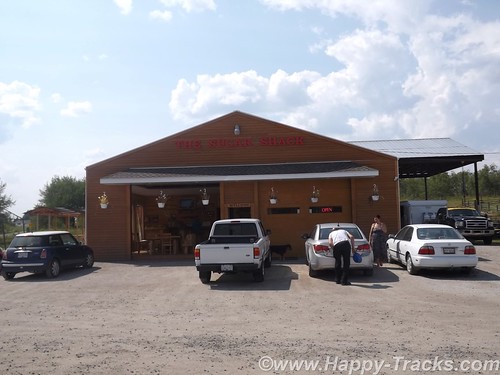

We stopped for lunch at The Sugar Shack, a side of the road eatery that looked to be in a building that could just as easily have been a large two car garage made from logs, complete with rollup doors. The special that day (and probably most days) was a Canadian delicacy, poutine. Originating in Quebec, poutine is a fast food dish sold in “greasy spoons” and roadside food wagons, made with French fries, topped with a light brown gravy-like sauce and cheese curds. (Can’t you just feel your arteries clog just reading that?) Easily large enough to be a meal by itself, it came as a side order to a brisket sandwich. They were also pushing maple sugar products but we passed on those.
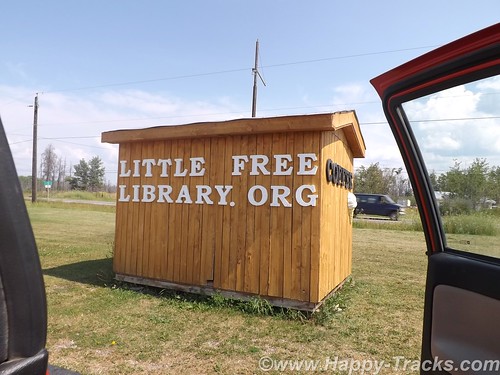

We continued on to Cache Creek for the night. When we pulled into town shortly before sunset, the thermometer was at 104! The room’s air conditioner got a workout but it quickly cooled to a more reasonable temperature after the sun went down. The room décor included a mural surrounding the clock on the wall, a large flower in the bathroom and a mesh drape hanging over the bed. As it was Monday night, the crowds had dissipated with only a couple of the other rooms being taken in the small motel.
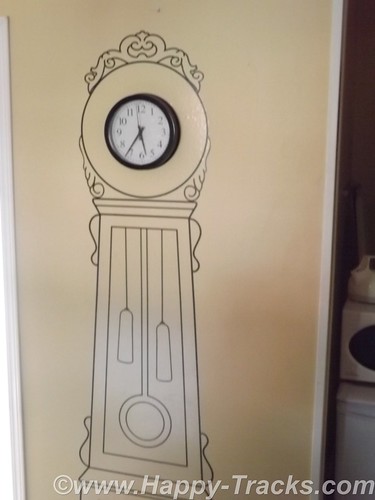
We went to the post office the next morning to get stamps for a couple of remaining postcards. The post office was tucked on a ledge into a little space between the Old Cariboo Road, a creek and a high bluff of rock. We left Cache Creek on the Trans-Canada Highway (Route 1) heading towards Frasier Canyon.
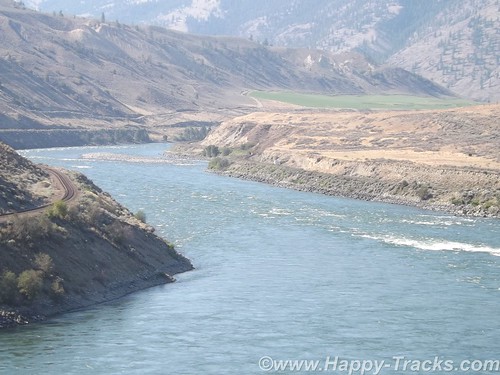

The scenery through Fraser Canyon was beautiful with the river leading the way. The landscape was greener than the day before.
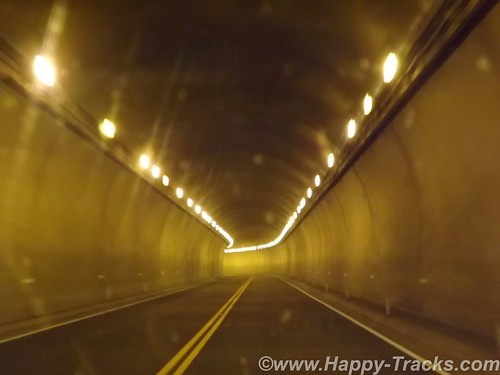
There are 7 tunnels built on the high banks of the river to allow the Trans-Canada highway to pass next to the rock bluffs and the railroad tracks.
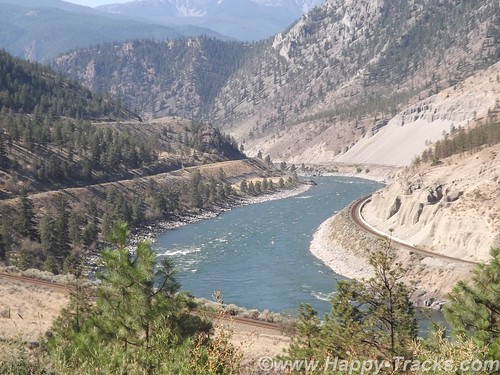
One unusual thing here is that there are single railroad tracks on each side of the river. One set of tracks was built by the US government and one set was built by the Canadians. Each was asserting their presence and ownership of the territory and not cooperating at all. The US trains ran on one side of the river both north and south, the Canadian trains ran on the other side of the river both north and south. It’s only been in the last 15 years that agreement was finally reached to allow cooperation so one set of tracks is used for northbound and one set is used for southbound, increasing the efficiency for both.
We noted that the steep drop offs from the highway are protected by guardrails in only some areas but not others. While we aren’t certain, it seemed that the places where a vehicle going off the road and hindering rail traffic was a concern, there was a rail. Where going off the highway did not endanger the tracks below, there was no rail. Hmmm.
The Fraser Canyon is popular tourist territory with water activities like rafting and fishing and the mountains on either side hosting winter snow activities along with hiking and climbing.
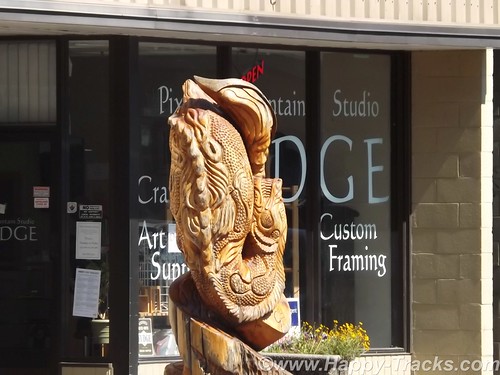
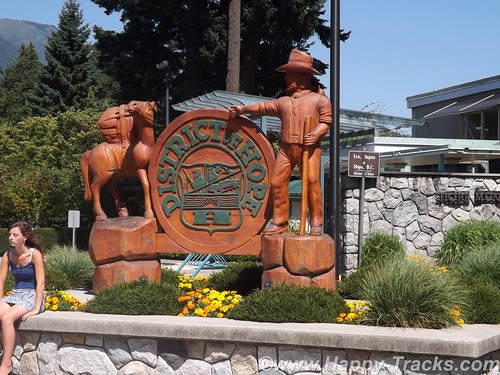
The canyon narrowed down to funnel us past the city of Hope where we took a break for lunch. Hope is a scenic little town with the river banks and an abundance of carved wood statues.
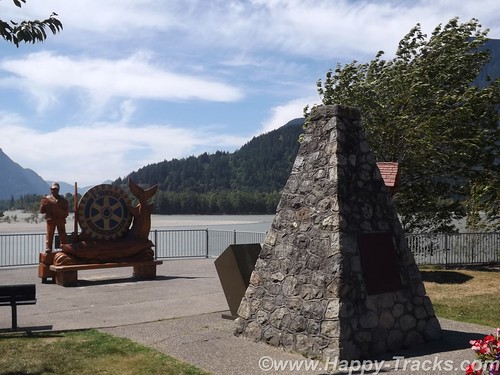
The statues are carved where the tree grew with the root structure. One story we read said that the trees were falling victim to blight and the chainsaw carvings were seen as a way to make use of the dying trees. Other chainsaw carvings were commissioned works. One of my favorites was the troll with the mouse in his beard.

Shortly after passing out of Hope, we turned west through farmland backing to low mountains and made our way toward Vancouver.
You can see all of the pictures from this leg of the trip here.
We invite you to continue along with us and hope you enjoy the account!
Tag Archives: Prince Rupert
Summer 2014: Alaska via the AlCan; Inland Passage via Ferry
In looking carefully at a map of Alaska, one first notices the size of the state and its coastline and how much vast space with no roads. In the interior, the distances are covered by bush and float planes like we saw in Anchorage. This works on the rugged coast between the islands but is remarkably inefficient in moving freight or if you want to use a vehicle to proceed beyond the landing spot.
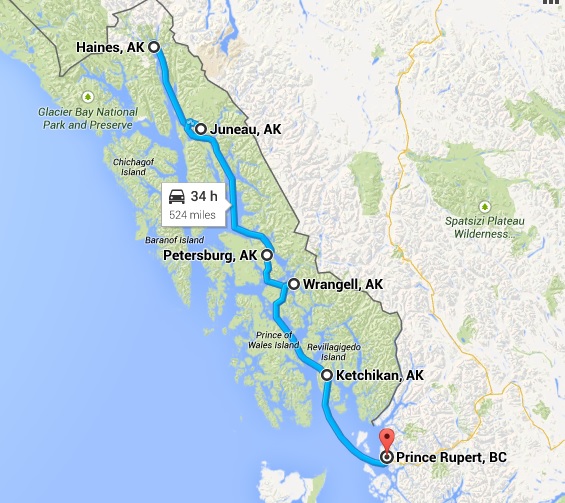
In 1948, three Haines residents Steve Homer, Ray and Gustav Gelotte, purchased a surplus US Navy landing craft and began providing ferry service for up to 14 cars with very crude provisions for passengers. After a couple of years, it proved to be economically unsuccessful and was subsequently purchased by the Alaska territorial government. The service proved useful and was expanded with bigger and better vessels and more towns served. As we mentioned in the Haines posting, the distance by water between Haines and Skagway are only 20 miles apart by water but hundreds of miles distant by car. Other cities in Alaska, including Juneau, the capital, are totally unreachable except by boat or plane.
The Alaska Marine Highway System over the ensuing decades now transports folks, vehicles and freight over the broad range from Bellingham, Washington over 3500 miles to Dutch Harbor, Alaska in the Aleutian Islands.
As I was working on our itinerary, I had us in the Wrangell-St. Elias area with plans to go down towards Washington and the ferry seemed to be a perfect way to give us a break from the drive, fuel and hotel costs and let us see the Inland Passage. My haste didn’t allow me to see that there was no direct road route to Haines for our trip, another case of serendipitous planning taking us to a particularly enjoyable part of our journey.
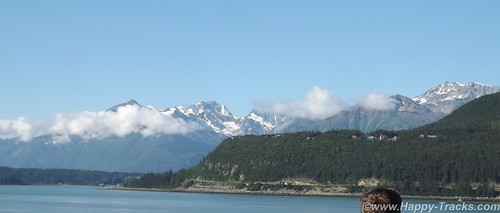
Our ferry ride took us about 475 miles by water in 39 hours to cover what would have been 915 miles by highway over perhaps 3 days. Had we driven to Prince Rupert, we would have seen some parts of British Columbia that we didn’t but we would have missed the Inland Passage and all its beautiful sights. You do miss things in the truck as you’re making miles and watching for signposts and directions. You also miss some of the conversations and people watching opportunities.
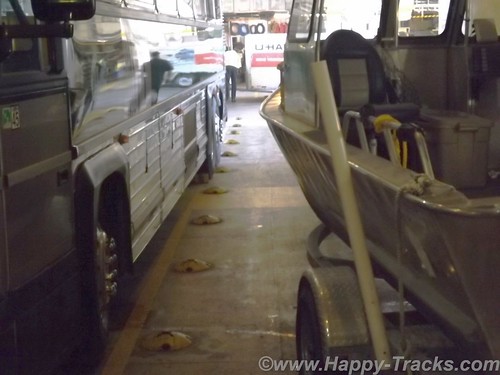
We drove onboard on a ramp which took us down to a lower level of the ship or the car deck. The car deck held all manner of vehicles. There were passenger cars and pickups like ours. There were tour buses and motorcycles. There were huge RVs, both motorhomes and fifth wheel campers. There was a truck pulling a boat on a trailer and there were the trailer halves of tractor trailers that were traveling unaccompanied and maneuvered about by tractors at their embarking and disembarking ports.

While at Homer, we had seen the MV Kennicott loading but it had a vehicle elevator and turntable for ports that don’t have facilities for the ramps. The car decks are secured and not accessible to passengers while underway. Folks traveling with pets bedded them down in the vehicle and went down to check when we pulled into port.
After securing the truck, we went upstairs to the purser’s desk for our cabin assignment and keys. We had reserved an outside cabin but some folks had plans to stay in the common areas or even to pitch a tent on the upper level sundeck (which has heat lamps under the roof).
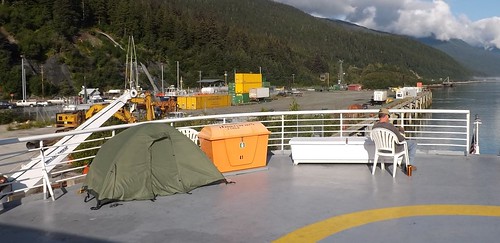
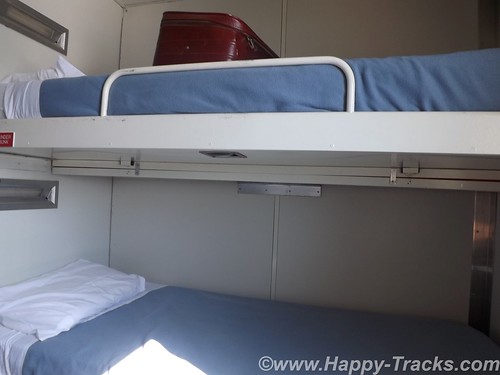

The three bunk outer cabin has an upper and lower bunk on one bulkhead and a single lower bunk at right angles and against the outer bulkhead with a square window above. There is also a fold down desk in one corner. There was a small head with a shower stall, a sink and a toilet angled into the corner. While usable, it required a bit of thought about what you intended to do in figuring the way you entered.
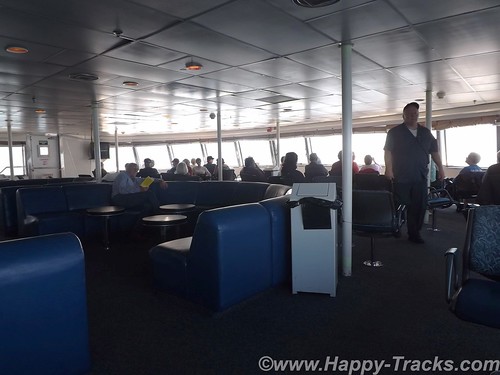
The deck above the cabins has a forward observation deck with comfortable chairs and a panoramic view. There is even a small kids’ play area and some tables for games and cards.
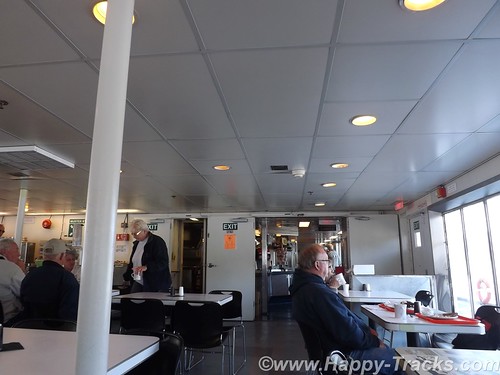
Immediately aft of the observation lounge is a bar and lounge which sometimes has a musical performer. Over the course of our trip, we only saw a few folks here. Continuing aft, the line for the cafeteria runs along the starboard side and the cafeteria was open all day except for an hour before each meal change. Overnight, sandwich service rather than hot meals were available. Aft of the cafeteria’s serving line was a dining area that was open around the clock.
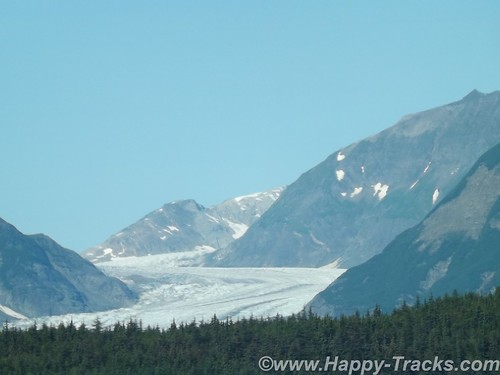
Each deck also had an open area on the stern. There were two or three areas on the outer decks where smoking was permitted at times.
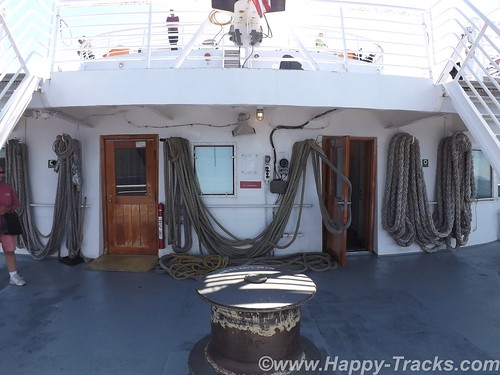
Our route included four stops before our final destination of Prince Rupert BC.
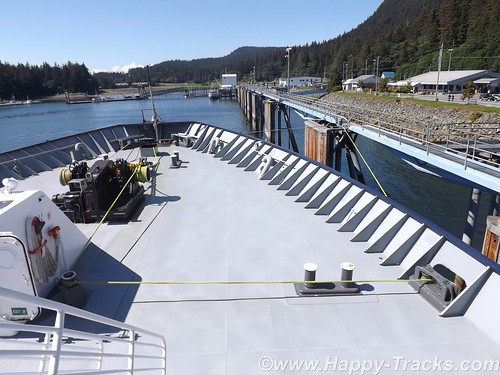
Our first stop was at the ferry docks outside of Juneau. The dock is located north of the main part of town in Auke Bay like the dock in Haines so we didn’t really see the town. We were in port a couple of hours and there were vans waiting at the dock to take folks into town for a tour. We chose to stay near the dock and enjoy the warm sunshine.
Juneau was established in 1880 by Joe Juneau and Richard Harris. They discovered gold in nearby Gold Creek. The mine eventually became the largest operating mine of its kind and operated from 1880 to 1944. The capital was moved to Juneau in 1906 from Sitka. Points of interest besides the mine include the Mendenhall Glacier and the Capitol Building which is trimmed in Tokeen marble mined in SE Alaska.

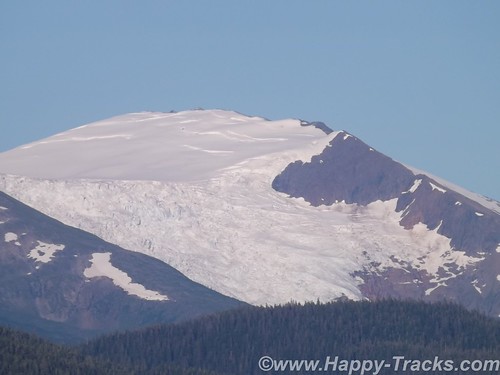
After we left Juneau, we threaded our way south towards Ketchikan. Late in the afternoon, we made our way to the observation lounge where we were delighted to see whales out in front of us. There was a tour group in the observation lounge at the same time and the group would call out when one was sighted making it easier to spot them. We also saw seals on a chunk of ice and boats fishing.



Later, we had a conversation with one of the crewmen whose job includes steering the ship. He told us that the whales were humpback whales and orcas. Environmental concerns force the ship to slow or change course to avoid them, at times even coming to a dead stop when there are just too many whales to safely proceed. He told us that the ships sonar setup allowed them to see and identify the whales even underwater. He also told us of watching a humpback whale on the sonar once that was being pursued by orcas but that the humpback is able to dive deeper and more steeply and escape the orcas if the water is deep enough.
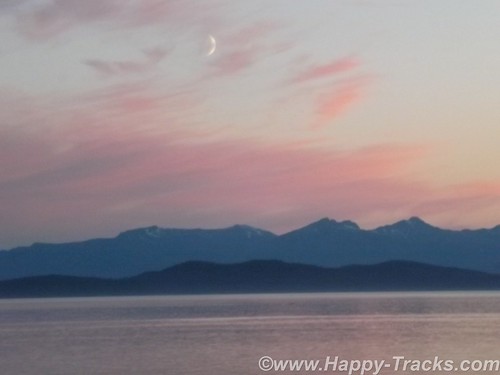
The scenery throughout our trip continued to be breathtaking and the sunset over the mountains and on the water was captivating.
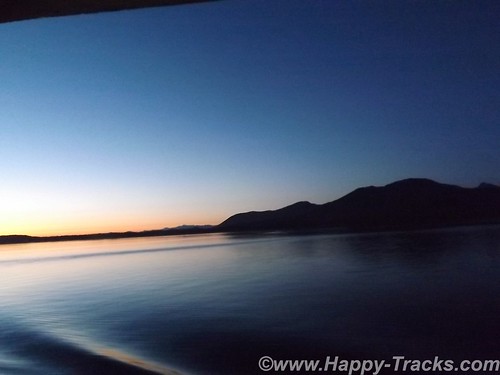
Another conversation we had with fellow travelers gave us tips for our return trip home. This particular couple had traveled part of the AlCan as we had but their trip had taken them further north into Yukon Territory and on the Top of the World highway. He shared that their trip had been over less friendly roads and had probably more closely resembled the conditions found by my family in their trips over the AlCan in the early 1950s. These folks were from North Dakota and asked about our route home. They recommended that we consider the North Dakota Badlands on our return route. We took their recommendation and were glad that we did.
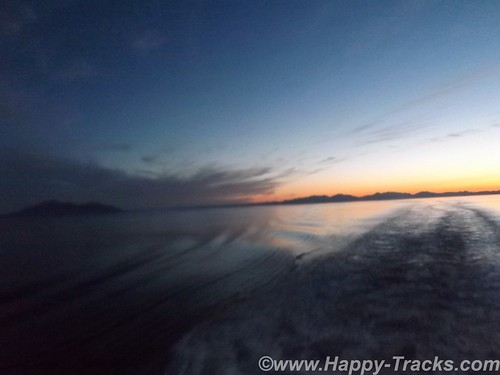
Our conversation with the woman working the cash register for the cafeteria line told us a bit about their jobs as well. The crew, depending on the route and ship assigned, may leave home and stay onboard for 2 weeks. When they reach the end of their two weeks, they have two weeks off before repeating the cycle. Depending on the job, they work 12 hours per day, perhaps split into 2-6 hour shifts.
We retreated to our cabin for the night and slept well, only waking when we pulled into our stops in Petersburg and Wrangell during the night. From our cabin window, we could see buildings that looked like they belonged on a pier, some type of warehouse or terminal and bright lights in the darkness.
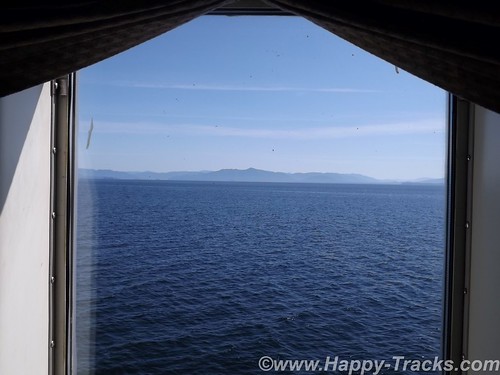
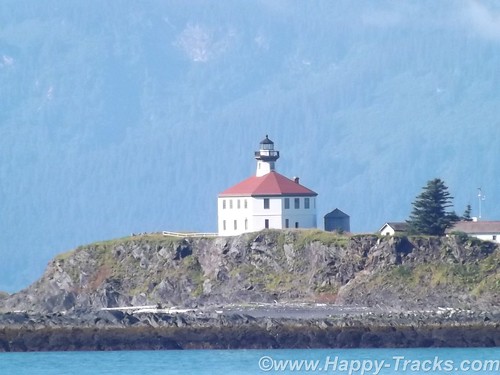
The next morning, we were back walking around on deck watching the scenery roll by. As we approached Ketchikan we saw several lighthouses and even a USCG helicopter land at one of them. We pulled into a busier port at Ketchikan than we had been seeing.
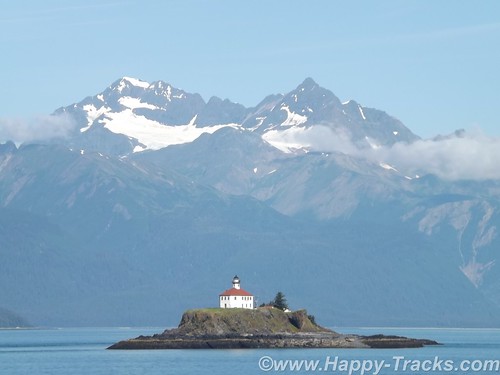
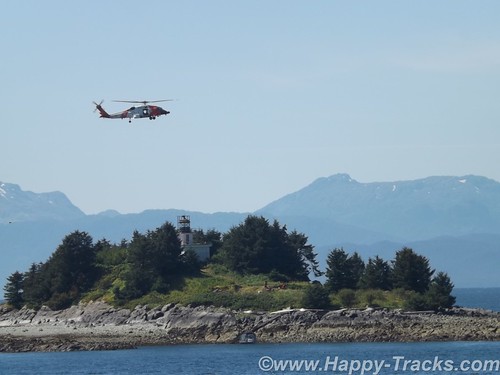
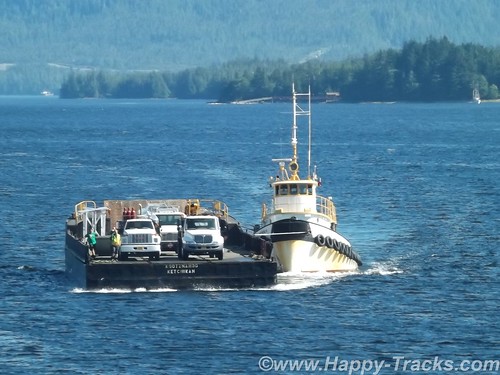
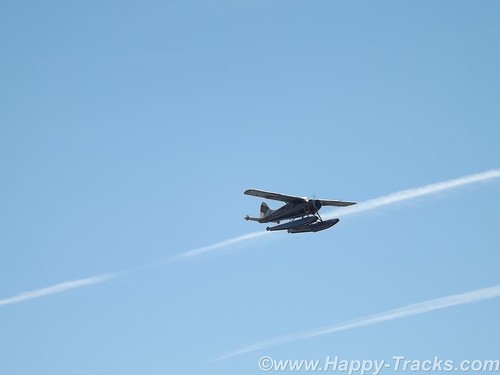
The Tongass Narrows, the waterway leading to the town’s docks, was in use by fishing boats and working boats of all sorts. This was also the channel that served as the local seaplane strip. On the opposite side of the channel from town was an elevated airport on Gravina Island. The airport is connected to town by a small ferry which takes about 7 minutes to cross from side to side. You may remember the Tongass Narrows and Gravina Island as the “Bridge to Nowhere” which gained notoriety as an earmark in the 2005 Federal budget. Perhaps I should also ask whether you remember Federal budgets and appropriations bills as opposed to “continuing resolutions”? Gravina Island has only 50 residents and the bridge (at an estimated cost of almost $400 million) was labeled as a particularly egregious example of government waste in the form of pork barrel spending. Proponents of the bridge said it was not just for the benefit of the 50 residents but to allow development of Gravina Island.

Our stop in Ketchikan was scheduled for 4 hours to allow the ship to take on diesel fuel to continue our trip into Prince Rupert. Since we had been unable to find postcards since leaving Haines, we disembarked and went into the commercial area near the dock. We tried a hotel and a restaurant and finally found the postcard at an A&P (Alaska and Proud) grocery store.
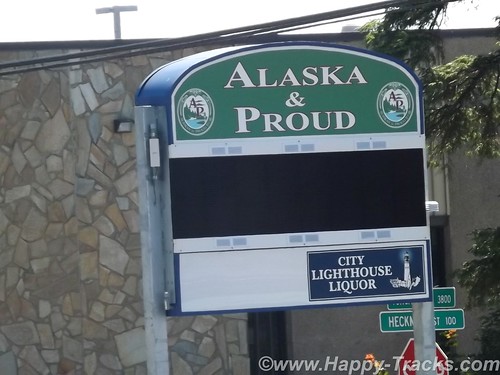
We went back onboard for lunch and asked the purser about mailing our postcard. She told us that it wouldn’t go out until after the ship went back north the following week but told us the post office was at the edge of the ferry dock parking lot so we went back ashore to the post office.
Leaving Ketchikan, we stayed within the Tongass Narrows for some time and got to enjoy some inland scenery from the water.
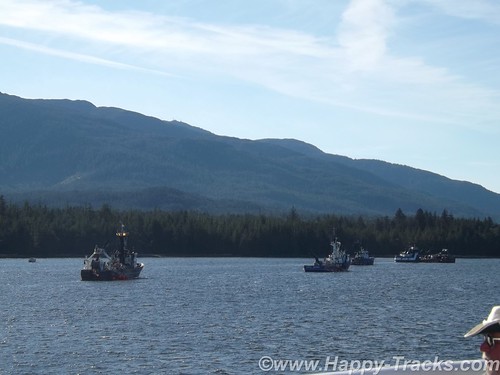
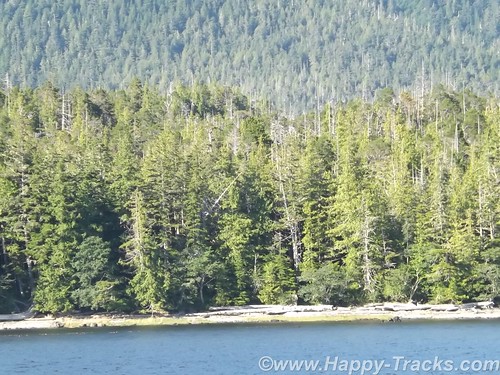
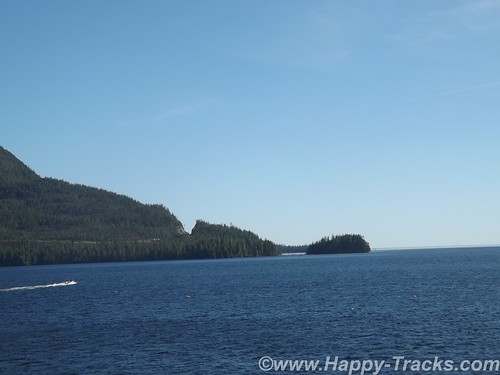
We were going to be landing in Prince Rupert around midnight and didn’t have reservations. We overheard some folks talking about driving on to Prince George as they expected it to be hard to find rooms in Prince Rupert. Prince George is 9 hours from Prince Rupert and while the fog would surely dissipate as you left the coast, it didn’t seem like a palatable alternative to us. The purser did have a list of hotels in Prince Rupert though with phone numbers. One of our fellow passengers was a German woman who was traveling without a vehicle and she was also trying to make arrangements for lodging but the language was creating a barrier for her getting recommendations. It wasn’t clear about how to get from the docks to the hotels and she was getting frustrated. We did share that the list was available and gave her one. We didn’t see her again and hoped she made a connection that was suitable.
We pulled into Prince Rupert in a heavy fog and the line at Customs was slow as the whole ship unloaded at once. We passed through relatively quickly (considering the line) and found a room just a couple of miles away at the downtown area of Prince Rupert.
You can see all of the pictures from this leg of the trip here.
We invite you to continue along with us and hope you enjoy the account!
